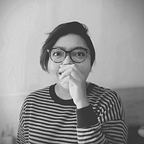A Fight for Love
This is a love story about a lovely human being who fell in love with art. How it shows characters through colours, how it expresses feelings without having to be loud and noisy, how its power lies within its beauty. Art sends the message from its creator in an abstract way, but somehow it still finds its way into people’s hearts. I can continue talking about art and how it stole my heart ever since I was a kid, way before I can even spell love correctly. In short, art really means a lot to me.
When I graduated from high school, my parents did not allow me to get into art school. In their opinion, I can’t make a living by being an artist. As the youngest child in the family, my parents wanted me to follow my two older sisters, taking a major with a better potential of making a living after graduation. The rebel inside me didn’t want to listen. I was (and still am) in love with art.
Finally, the universe gave me a sign. I found a university that offers Visual Communication Design major under the Faculty of Engineering. I then told my parents that I am not going to be an artist, but I am going to be a designer. That’s my way of convincing them.
Apparently, I found out that design is a perfect place for me to connect with art. After I create a concept to solve a human problem, art will help my concept ‘speak’ through different forms while maintaining both functional and emotional values.
I got the chance to make a living as an illustrator after I graduated, and I still enjoy working in this field. Through illustration, I can express my thoughts and explore ideas. During my journey as an illustrator, I also learned the amazing fact that colour can be the ‘glue’ for all design derivatives.
Up next on my journey, I took the opportunity to be a Graphic Designer. I learned how space isn’t always about emptiness, it’s also used to create balance in a design. Space or emptiness can also complete a design.
A while ago, I began working in my new role as a Visual Communication Designer. My responsibility is to communicate a message or idea to the audience using visuals as the language. The final outputs vary, such as posters, videos, motion graphics, display, etc. This role allows the most collaboration between me and art, and it challenges me to work to our full potential.
There was a time when I had to choose between trying a new role as Visual Designer or stay in my previous role as Visual Communication Designer. I thought to myself, “Why not go explore a whole new world?”. I also have an interest in human behaviour, so it seems like a perfect combination.
But the road was bumpy. I had a hard time during my role transition, which I didn’t expect at all. A friend told me that there is a blurred line between visual designer and graphic designer, and that “(Some) visual designers were once graphic designers.” but what she didn’t tell me was how it’s going to suck at the beginning.
Oh, how I struggled to survive.
I had to learn new tools, adjust myself to the design system, go through a lot of user testing sessions, and learn vocabularies of digital design.
The new tools didn’t bother me that much, I can still “Command + Z” things and google the shortcuts, so it’s fine. User testing is my favourite because I can learn about human behaviour and how it helps strengthen and/or justify my concept. As for learning vocabularies of digital design, there’s no way to cheat, I’ll just have to practice and memorize.
The design system is the one that I found difficult to adjust to. As an illustrator, I am used to starting my work with a blank canvas, all from scratch. Now, I also have a blank canvas, but it doesn’t feel like it since I can’t actually create something new. Everything has its own system that I have to follow. However, it also acts as a guide and library where I can find previous components. After all, the system is supposed to make my work easier so I can invest more of my time to understand users’ needs.
The design process isn’t much different since visual designers and graphic designers both focus on communicating through design while maintaining aesthetic values.
In my perspective, the difference is when a visual designer creates an interface design, there’s a chance it needs to be updated, considering the product team’s business decisions and new corner case from user data.
Do I still together with art? Yes, of course. This time, it has evolved from just a form of execution into a way of thinking. It allows me to create an assumption of how users will use the product. It helps me create a design based on what I learned through user testing while also maintaining its aesthetic qualities.
I have proved to my parents that being stubborn once was what got me here.
I have also proved myself how much I am capable of, how I can adapt, how I can keep improving myself while doing something I love.
My journey was long and bumpy, but it proves that when you love or when you’re passionate about something, in the end, it’s going to worth all the effort.
I hope my story could inspire you to not give up on what you love, even if it means you have to go through a little bit of an unpleasant journey.
